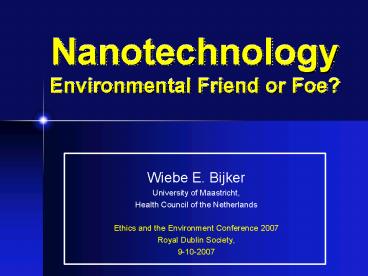Nanotechnology Environmental Friend or Foe - PowerPoint PPT Presentation
1 / 20
Title:
Nanotechnology Environmental Friend or Foe
Description:
Nanotechnologies offer important opportunities to biotechnology and genetics ... New forms of multiplex screening. Coatings and tissue-engineering: Biocompatibility ... – PowerPoint PPT presentation
Number of Views:128
Avg rating:3.0/5.0
Title: Nanotechnology Environmental Friend or Foe
1
NanotechnologyEnvironmental Friend or Foe?
- Wiebe E. Bijker
- University of Maastricht,
- Health Council of the Netherlands
- Ethics and the Environment Conference 2007
- Royal Dublin Society,
- 9-10-2007
2
Key points
- Nanotechnologies offer important opportunities to
biotechnology and genetics - Nanotechnologies possibly entail serious risks
- Policies need to pay attention to risks and
benefits from the very beginning
Ethics Governance
3
What is nano?
- Nano science and technologies
- Scale 1-100 nm
- Top-down bottom-up approaches
- High expectations yet few commercial
applications (sun crèmes, tires, opto-electrical
layers, aseptic layers, ...) - Heterogeneous, enabling technologies
- Promises and risks?
- Nothing new, merely very small?
- Fundamentally new phenomena?
4
Possible (medical) applications
- Drug delivery
- DNA- other biochips for diagnosis
- New forms of multiplex screening
- Coatings and tissue-engineering
- Biocompatibility
- Bio-degradable implants
- Anti-bacterial properties
- Mechanical properties
- Lab-on-a-Chip ?
- Biosensors
- Point-of-care applications
- Decentralisation health care by
- New forms of self-diagnosis
- Home-care technologies
- Active implants
- Retina
- Insulin pump
- Neural prostheses
- Brain-machine interfaces
- Human enhancement
5
New problem(due to special character of nano-
developments)
- Promising developments that deserve support
- Serious indication for damage, but no firm
scientific evidence yet - Unclear to what extent existing rules
regulations are adequate
6
Key questions
- How to balance risks and promises
democratically? - How to integrate ethics into nanotechnology
policies? - How to combine scientific expertise with
citizens participation? - How to govern science and technology?
Since we live in a technological culture,
governing technology is governing lifestyle
7
Health Councils report
- Use existing regulation, but do check its
adequacy - Apply precautionary principle, but framed within
a broader risk governance approach - Stimulate research
- Positive applications that are not commercially
attractive - Nano-toxicology
- Social sciences and humanities studies of
societal effectsand social embedding - Broad monitoring committee
8
Precautionary principle
- Intervene
- because there are serious indications of damage
- although there is insufficient scientific
knowledge
9
Discussion of Precaution
- Two versions
- Strong if no proof of safety, do not apply
- Weak lack of certain knowledge is no reason to
abstain from intervention - Burden of proof
- Reversal?
- Redistribution!
- Evaluation between extremes such as
- the end of all innovation !
- at last we can stop capitalist technology-push !
- Problem when and how to apply?
- (cf. Wittgenstein)
10
Approach
- Key element of democracy not everyone needs to
participate in everything, all of the time - Try to be specific about risk situations, types
of expertise, forms of participation, concrete
policy measures
11
Risk Governance sources
- International Risk Governance Council (Geneva)
- Health Council of the Netherlands
- Also drawing on UK Royal Society Royal Academy
of Engineering - Adopted by Dutch government (Nov. 2006)
12
Risk Governance core idea
- Classify risk situations
- For each risk situation, there is an appropriate
- Approach of risk management
- Set of involved experts/groups
- Set of possible risk management policy
instruments - Continuously monitor ST developments and risk
situations
13
Risk Governance classification
14
Examples of classification
15
Risk Governance instruments
16
HC recommendations (1)
- Politics
- Risk governance as conceptual framework
- Precautionary principle for free, non-degradable,
synthetic nano particles - Broad monitoring-committee
17
HC recommendations (2)
- Research agenda
- More targeted nano-toxicology (incl. tests,
concepts, screening strategies) - More social sciences and humanities research
- Stimulating trans- en multi-disciplinary research
without direct commercial promises - Structural inclusion of CTA (Constructive
Technology Assessment) in nano sciences and
technologies
18
HC recommendations (3)
- Participation scientists, stakeholders,
citizens - Increasingly in risk situation that are
- Simple
- Complex
- Uncertain
- Ambiguous
19
HC recommendations (4)
- Socially responsible management and governance
- Life cycle analyses
- Adaptations within REACH
- Reflexively-critical attitude, also by government
agencies
20
w.bijker_at_tss.unimaas.nl http//www.gr.nl































